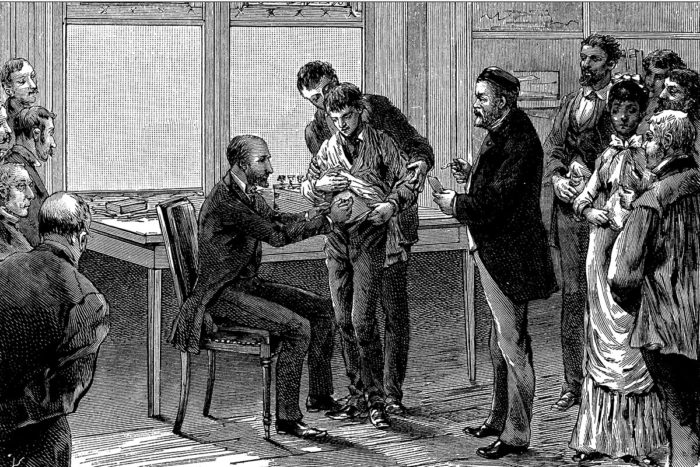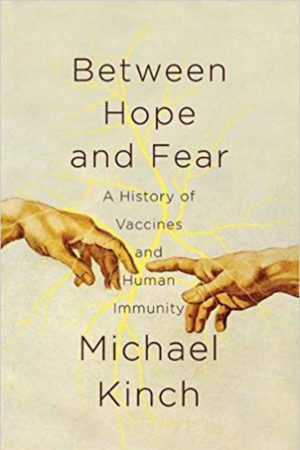Fighting the vaccine wars on the side of science
Kinch writes about one of humankind’s greatest inventions
 Getty Images
Getty ImagesA historical engraving depicts a patient receiving rabies vaccine in the abdomen. Michael Kinch, PhD, has published a book on the history of vaccines and human immunity.

More lives have been saved by vaccines than any public health initiative, save clean water – yet millions of people worry that vaccines are a threat to themselves and their children. Such fears result in vaccination rates dropping, opening the door to outbreaks of preventable diseases such as measles, mumps and whooping cough.
Michael Kinch, PhD, an associate vice chancellor at Washington University in St. Louis and director of the Center for Drug Discovery, has written a book to counter some of the most destructive misperceptions of lifesaving vaccines. His book, “Between Hope and Fear: A History of Vaccines and Human Immunity,” tells the story of the people behind vaccines and how the human body fights infection. Kinch is also director of the Center for Research Innovation in Biotechnology, and a professor of biochemistry and molecular biophysics and of radiation oncology.
Why did you write this book?
For the last six years, I’ve been assessing the sources of innovation and entrepreneurship in new medicine and vaccine development. In the course of doing that, I realized that most of the stories we’re told about vaccines are wrong. So I went back to correct the record.
For example, everyone learns that Edward Jenner invented vaccines. The story is that he noticed that milkmaids have beautiful clear skin. They don’t get smallpox – which leaves scars all over – because they get cowpox instead and that protects them. But in fact, it was an English farmer, Benjamin Jesty, who noticed the milkmaids’ skin and performed the first vaccinations two decades earlier. He walked for miles in the midst of a smallpox outbreak until he found a cow with cowpox and then used his wife’s knitting needles to scratch the skin and inoculate his wife and children. Jenner popularized it, but Jesty invented it. And when his neighbors heard about what Jesty had done, they ran him and his family out of the village. They had to move 100 miles away.
Why were they run out of the village?
There was a fear that because they were mixing cow material with human, they were going to turn into some minotaur-like creature at night and kill everyone in the village. We can laugh at that fear, but right now we’re experiencing our own vaccine fear in the form of Gardasil, the cervical cancer vaccine. Not because of its safety; it’s totally safe. People are attacking it as the “promiscuity vaccine” with the idea being that now that teenagers know they’re not going to get cervical cancer, they’re going to be more sexually active. That’s not likely. The anti-vaccine movement has been around longer than there have been vaccines, and oftentimes it is entirely irrational. That’s really the story of this book. Every breakthrough is followed by a backlash or a tragedy.

How was there an anti-vaccine movement before there were vaccines?
Before there was true vaccination, there was variolation, where people were deliberately infected with smallpox through a scratch on the skin. Up to 10 percent of people who were variolated died, which is not good, but it’s better than the 30 percent or so who die from natural smallpox infection. When Cotton Mather, who was a prominent Puritan leader, promoted variolation in the Massachusetts colony, people threw bricks through his window and accused him of trying to kill their children. And there have been screw-ups that caused real tragedies. There was a batch of polio vaccine that wasn’t properly inactivated and caused a big polio outbreak in California. So yes, sometimes there’s a bad batch. Sometimes there’s a bad vaccine. That’s human nature. We make mistakes. But no other man-made product has saved more lives than vaccines.
Are scientists winning the argument against the anti-vaxxers?
Certainly, if you go on Twitter, anti-vaccine messages are outperforming pro-vaccine five or six to one. I don’t think we’re winning. I think we’re starting to lose. Ukraine has more than 30,000 cases of measles this year. Mizzou had a terrible mumps outbreak, hundreds of cases. And it’s a shame. It’s more than a shame, it’s a tragedy. I’m not out to vilify antivaxxers. I don’t doubt that they care about their children and they care about other people’s children. But scientists are doing a lousy job communicating with the public about it. The evidence that vaccines are safe and effective is so overwhelming that scientists don’t want to talk about it anymore. They think the matter is settled. But they don’t recognize that we might have the facts on our side but we’re still losing the war on vaccines.
What do you want people to take away from this book?
The biggest thing is to get access to the facts. The real facts, not what you see on Facebook or Twitter. More often than not, the things you see on Facebook and Twitter are manipulated to play on your fears. That’s why I wrote this book: To give an objective view, lay out the evidence for everyone to see. Other than clean water, nothing has saved more human lives than vaccines. We need to appreciate that.






